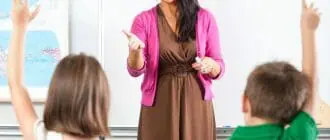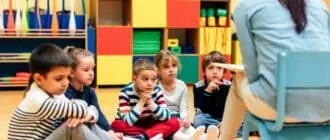Running an efficient classroom takes effective planning, preparation, and procedures. Educators in elementary school, middle school, or professors in college can promote effective classroom routines by implementing and modeling practices that become a natural part of the environment.
While classroom rules are also very important, classroom procedures are clearly defined ways of accomplishing specific tasks within the school or classroom.
Having procedures and routines in the classroom will help students to know exactly how to complete tasks. This prevents confusion but also gives students some responsibility for their actions within the classroom setting.
Importance Of Classroom Procedures

Have you ever been to a large event or highly populated gathering? Think about the tools you use for finding your way around. Are there signs and arrows that show you where to park your car? Do you have to purchase a ticket or use an application on your phone to sign in?
In order for a large group of people to function effectively in a busy environment, there must be clearly identified instructions and directions to show people how to behave.
Your ultimate goal as a teacher is to provide high-quality instruction to your students. It doesn’t matter how amazing your lessons are if the students cannot participate in their learning because they are distracted by other student behaviors.
Classroom routines that are consistently implemented will also reduce the number of off-topic questions generated by students, which can disrupt the momentum of a great lesson.
Also, consider a time when you were in a new environment. Many children feel nervous or anxious about being in a new classroom. If procedures are explained clearly, the children will have more confidence about how to function at school instead of uncertainty or fear.
What Are Examples Of Classroom Procedures?
Procedures are defined as a series of actions that are completed in a certain way or a certain order. Having procedures in place takes the guesswork out of handling small, daily tasks.
Some classroom routines and procedures examples include:
- Showing students exactly when and where to turn in their classwork
- How to transition in the classroom or while entering and exiting the classroom
- Steps to take before, during, and after lunchtime.
One of my favorite procedures was the incorporation of a timer at the start of my classes. I used this practice successfully with both younger and older students.
If you have a computer screen, Smartboard, or projector, you simply project a digital online countdown timer on the board where all students can see it clearly.
I would start each class with 5 minutes on the board. I taught the students to use this time in order to organize their materials, go to the restroom, sharpen their pencils, and so on.
When the timer ended, the students need to be seated quietly, pencil in hand, ready to work.
Classroom Procedures Elementary

Elementary classroom procedures must be thoroughly explained in advance and practiced regularly throughout the school year.
The classroom procedures elementary students utilize the most typically include expectations for lining up, entering the classroom, and packing their backpacks for dismissal.
One routine I implemented in my first-grade classroom for lining up was called, Beat the Timer. Student desks were grouped in pods and each group was numbered 1-4. I would call tables by number and the students would quietly walk to the door and line up one-by-one.
This became a fun routine because I would set a stopwatch and every day we would try to “beat our time” from the previous day. Students knew that if they were talking or playing around, they would waste time.
I often even pretended to close my eyes or look the other way so that the students could surprise me with their nice, quiet line! Then we were ready to head out the door for lunch, recess, or other activities.
Classroom Procedures High School
Classroom procedures examples for high school students will be different than procedures established in lower grade-level classrooms.
For each of my four classes, I designated a specific color- blue, green, red, orange. Within the classroom, I used paper collection trays, posters, and even baskets, all labeled in four specific colors. By doing this, students could easily identify the materials for their class.
When my students came into the classroom, they would grab their lesson materials from the basket designated for their class and take their seats. At the end of class or upon the completion of an assignment, students would place their work in the coordinating collection tray.
Jump In: Make sure you always have a Plan B tucked away in your desk in case the need arises. Know the importance of having one by reading my article: Emergency Sub Plans.
Frequently Asked Questions
1. Is it important to have classroom procedures?
It is extremely important to have classroom procedures! Do you care if students get up and sharpen their pencils while you are in the middle of teaching?
Do you want students to turn their papers in after class by placing them on your desk, leaving them on the table, or putting them in a folder, binder, or paper tray?
If students are not clearly shown what you would like for them to do, everything will be confusing for them. Students need to be taught the expected behavior you would like for them to do when handling various situations.
When students need to go to the bathroom, is it okay for them to simply walk out of class? Do you need students to take a hall pass, sign a log, or raise their hands and ask for permission?
Specific procedures that have been explained, modeled, and practiced will save you so much time waiting for students to complete tasks, answer questions, or fend off behavioral distractions.
Your classroom environment will be much more conducive to learning with routines!
Learn more in this video of establishing classroom routines:
2. How do you introduce classroom procedures?
When implementing a new classroom procedure it is helpful to share the overall goal or purpose for this new policy. Explain to students what the problem is and that your school has developed a new way to solve the problem.
Then, show students exactly what you want them to do. Physically walk through the steps. You can call on students to practice and model the routine several times. The younger students need to do more repetitions in order for them to really grasp the exercise.
For example, one year my school had too many fourth-grade students going down the hallway to use the restroom at the same time. In an effort to limit the number of students in the restrooms, the fourth-grade teachers decided to implement a new procedure.
When a student needed to use the restroom, they would ask permission. When permitted, they would take a large plastic cone from the bookshelf and place it on their desk before leaving the room.
When I saw the cone on the child’s desk, I knew they were at the restroom. You wouldn’t have to use a cone. I have seen toys, cups, trophies, or even the hand sanitizer bottle used for this classroom procedure!
The most important thing to remember is to be consistent. Practice, model, and demonstrate the practice in action for the best classroom management.
Next Steps To Take
Grab your classroom routines and procedures checklist and let’s get ready to implement some of these practices into your classroom!
Consider the following:
- What do students need to do when lining up?
- Do students know what to do upon entering the classroom?
- What do students do with their classroom supplies?
- How should students turn in their classwork or homework assignments?
- How do you expect students to ask for help or get your attention?
- What are your routines for dismissal at the end of the day?
Once you have decided which classroom procedures you want to implement, you are ready to share them with your students. Don’t try to teach too many procedures at once.
Focus on one teaching the procedures individually, and spend enough time practicing so students have the routines mastered.
You will notice a major improvement in your classroom management and positive student behaviors after utilizing procedures for tasks students must do in the classroom each day.
Last Updated on July 24, 2022 by Emily
- Facebook9
- Twitter21
- Pinterest67
- 97shares




